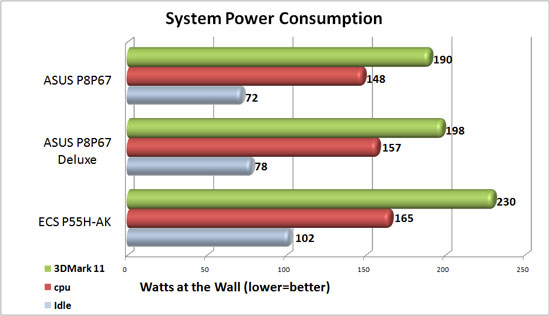ASUS P8P67 and P8P67 Deluxe Intel Sandy Bridge Motherboard Review
System Power Consumption

Since power consumption is a big deal these days, we ran some simple power consumption tests on our test beds. The systems ran with the power supplies, case fans, video cards and hard drives. To measure idle usage, we ran the system at idle for one hour on the desktop with no screen saver and took the measurement. For load measurements, Prime95’s in-place large FFT’s was run on all cores to make sure each and every processor was at 100% load for maximum power consumption and heat. Curious about real world scenarios, we decided to drop Furmark and ran 3DMark 11 on the performance preset and took the maximum power consumption during the first GPU test.

When it comes to power consumption to performance ratios, the new Sandy Bridge platforms were able to take the cake. Idle power consumption of the ASUS P8P67 was 30 watts lower at idle than the ECS P55H-AK. The ASUS P8P67 Deluxe wasn’t quite as low as the ASUS P8P67 was; we do have to keep in mind that the Deluxe version of the board has a few more options built into the system which will draw power. During the real world test, the ASUS P8P67 was an impressive 40 Watts lower than the ECS P55H-AK and 8 Watts lower than the ASUS P8P67 Deluxe. Once again the difference between the two ASUS boards can be attributed to different features on the board.

Comments are closed.